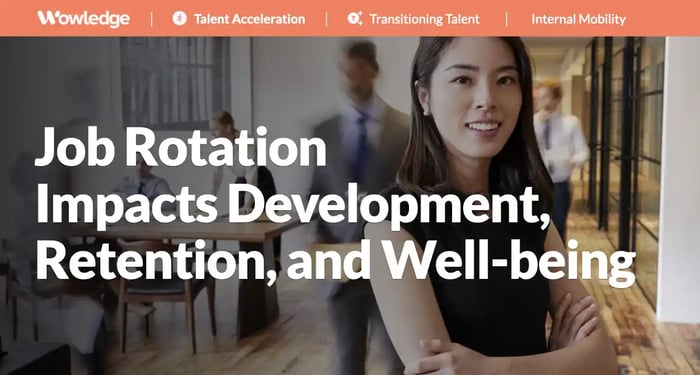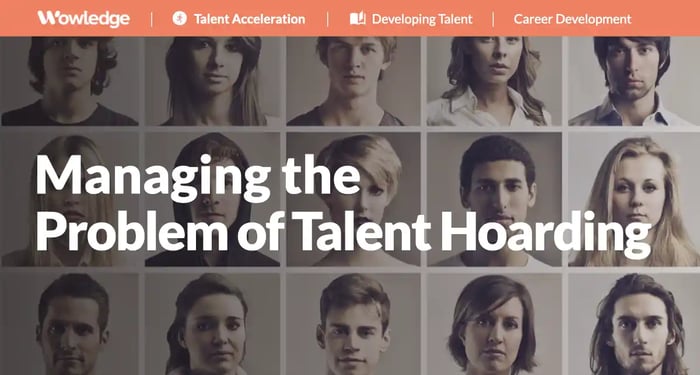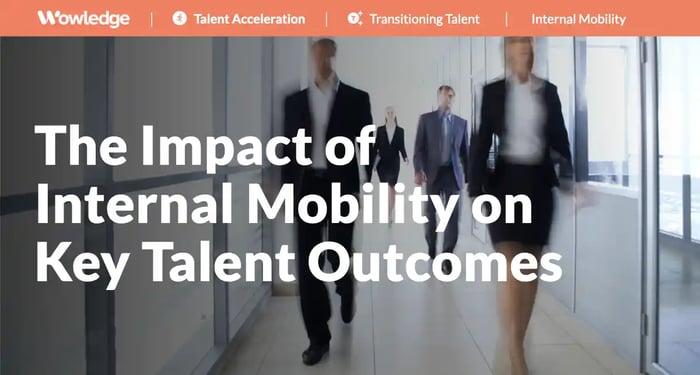The typical workplace faces high turnover, low employee engagement, creeping skills deficits and obsolescence, and increasing burnout among workers and their managers. As a result, organizations are looking for meaningful and impactful ways to respond. These challenges call for a range of integrated solutions and improvements. However, providing opportunities for career growth and skill development that offer new and often refreshing perspectives and challenges is particularly appealing. Enter job rotation to combat employee burnout, frustrations around a lack of development and advancement, and a reason for employees to continue their employment with the organization.
Implementing a job rotation program can empower employees, fostering a more versatile and resilient workforce. By allowing them to experience different organizational roles, job rotation enhances their skills. It broadens their understanding of the company's operations, leading to improved problem-solving abilities and innovation. This not only supports nurturing talent as employees discover new strengths and interests but also potentially leads to higher job satisfaction and retention rates. From an organizational perspective, having a workforce with diverse skill sets and experiences increases operational flexibility, making it easier to adapt to changes and fill critical positions when needed. Job rotation contributes to a more dynamic, knowledgeable, and adaptable workforce, crucial for long-term success in a competitive business environment.
Defining job rotations
Job rotation, a concept with multiple interpretations, can be seen as a series of short-term projects or a long-term career development strategy. It's often used interchangeably with 'job mobility' indicating its potential for short- and long-term applications. However, according to Wowledge’s experts, job rotation is not just a tool but best implemented as a strategic, career-long process that impacts employees at all levels. This broad understanding of job rotation inspires organizations to tailor its implementation to their unique needs and goals, making it a versatile and adaptable talent strategy.
In either case, job mobility refers to the movement between roles that is primarily lateral and conducted periodically to develop new skills, assess an employee’s strengths, fill critical capability gaps, and expand an appreciation of how different roles and business units contribute to an organization's success. This strategic approach to job rotation helps enhance the likelihood that a larger percentage of employees develop themselves in a way that increases the percentage of people who can be significant contributors to the organization.
The primary reasons or goals of a job rotation program are to enhance employee skills and capabilities, identify and prepare key role successors, improve the use of managerial-level talent, enhance collaboration and sharing of best practices, and increase staffing flexibility.
Job rotation programs can be leveraged as solutions in many use cases, such as:
- New hire onboarding
- High potential (HiPo) development
- Executive successor candidate preparation
- Upskilling of employees in preparation for movement into more critical roles
- Assessing successor and HiPo candidates’ abilities to adapt, learn, and grow into new functions, geographies, types of operations, or expanded roles
- Enabling the mobility of those employees who are motivated to grow and diversify their experiences and skills
Employees see rotations as a way to get “unstuck”
The reasons for considering rotational programs are abundant. Employees (74% of workers) increasingly report moderate to high levels of stress and burnout, and are looking for some relief. Amplifying that concern is the finding that 90% of surveyed workers said that they have felt stuck in their job.
That same study provided interesting insights that support internal job rotation's effect of keeping employees engaged and avoiding losing them to involuntary turnover. 43% are interested in moving to a new department or team. A change of scenery is clearly on their minds. Bolstering that point, 51% said they would stay with their current employer if they were given the chance to change career paths, 46% if they could work on new projects with different teams, and 44% if they could move into a new role.
Other research found that 95% of employees say job rotation programs would address their need for new work challenges. Among those who rotated into new jobs or projects, 90% felt that it helped them develop deeper skill sets (especially their problem-solving skills), 96% said that their productivity subsequently increased, and 84% reported increased collaborations with other departments.
We’ve seen how important development and growth are to the now-dominant (60%+ of the total labor force) Millennial and GenZ workers, and for them, job rotation is heavily in demand. For example, 75% of early-career managers are looking for opportunities for job rotations, while 66% of young workers (accountants and financial analysts, in this case) wanted job rotations to develop their skills.
While the desire for development and growth seems to dominate the motivations for employee rotations and mobility, some data suggests that job rotations are also positively correlated with promotion rates, supporting employee ambitions for advancement and growth.

Job rotations as a solution to new and critical workforce segments’ issues
Planned rotations can help lengthen the tenures of and protect investments in certain workforce segments, particularly those in strategically critical, high-stress, high-impact roles. Consider the roles where financial resources for recruiting and development are expended, or burnout and turnover are reported at high levels. Examples of such roles and the value-add of planned job rotation include:
Nurses with high rates of burnout, long work shifts, and irregular schedules and drive much of the ”patient experience” that healthcare providers bank on. Rotations can offer a break from the same recurring patient challenges, provide access to different schedule options, broaden their knowledge of different health conditions and treatment options, and build a greater appreciation and awareness of the value provided by administrative and internal “supply chain” work.
HIPOs (High-potential employees) need accelerated development and an appreciation of the company's operations. Rotations offer hands-on experience with how workflows and different functions interconnect, drive, and add value to achieving organizational objectives. They also expose them to a wider range of managers and management styles, coaching and mentoring from more experienced leaders, and opportunities to assess their interest and suitability for future potential roles.
New hires or graduates learning the business. The opportunity to rotate new hires through several related departments, functions, and/or business units provides a global understanding of how the organization operates. By understanding its operations and getting insights and guidance from a range of decision-makers and career influencers, a new employee can see how their (and others’) work fits into and contributes to the organization's objectives.
Salespeople need to understand the nuances of the products and services they are selling. A well-prepared sales professional should understand the internal supply chain that creates the products and services, how the external partners who supply or finish those operate, and how different roles contribute to their successful sales and delivery. Helping them understand the realities and effects of their actions and promises and learning facts about how products are developed, produced, shipped, etc., provide them with the know-how to effectively communicate and manage customer expectations.
Leaders and managers whose burn-out rates continue to climb and whose skills are being stretched and tested. The need to rotate these more senior professionals in and out of their people-leading roles has never been more pronounced. Planned rotations between people management, project management, and subject matter/technical expert roles offer the opportunity to leverage these employees' unique skills and experiences. In addition to avoiding burnout, the opportunities to leverage their experience portfolios as technical advisors, project leaders, innovation champions, etc., create a needed break from people management, which is taxing even for (only) 10-30% of those who are deemed as qualified and successful in that role.
The benefits of rotation programs
The value-add of job rotation programs to the organization and the individual employee appears substantial. Aside from addressing employee preferences for advancement, movement, and development that can drive engagement and retention, data provides strong messages about other desirable outcomes. For example, a large-scale meta-analysis of research studies covering over 280,000 employees found significant positive effects of job rotations on job satisfaction, organizational commitment, career success, labor flexibility, general psychological health, job performance, productivity, and easing of stress/burnout.
On research effort demonstrated A significant and favorable relationship between job rotation and employee performance, knowledge and skill development, and productivity. Meaningful for organizations, widespread employee movement is twice (2X) as likely to be a practice associated with high-performing organizations.
Anecdotally and from experience, rotation programs are also effective methods for:
- Assessing employees’ fit with different types of roles for guiding their career development
- Providing cross-functional and/or enhanced depth of experiences to prepare them for more demanding (e.g., subject matter expert) or higher-level (e.g., management or leadership) roles
- Enhancing employees’ professional adaptability, and agility to handle future organizational changes more effectively
- Providing hands-on learning, guidance, and direct coaching by different managers and more experienced peers in new environments
- Keeping key employees fresh and excited about their career and growth prospects
- Strengthening and broadening employee networks for enhanced collaboration and innovation
- Increasing staffing flexibility with more employees cross-trained
- Improving well-being for manual laborers with lessened physically repetitive tasks
- Improved sharing and transfer of new and best-practice work methods, ideas, and knowledge
- Minimizing the “silo mentality” of workers to improve within and cross-team functioning
Common challenges with rotation programs
Organizations that have used rotation programs understand that there are numerous potential risks and downsides to moving employees between roles in a planned and methodical manner. They are primarily lower-risk due to a) their short-term nature and b) internal hires' tendency to perform better than their external peers who must adapt to new work methods, styles, and cultures. That said, managers and leaders should set expectations regarding potential issues that must be managed.
Lower initial productivity
Compared to a continuous role holder selected due to a strong overall job fit, the short-term employee often has many but not all the needed and desired capabilities. Given that these moves are considered development vehicles, the speed-to-competency may take longer, and the managers and peers should be prepared to coach and guide the new team member to full contribution levels.
Mismatch with one's skills, abilities, and/or work style
There is a risk that a newly placed individual appears to have the necessary skills and abilities on paper but cannot exercise those as the work requires. This could be due to work volume or technical demands that prevent the manager or teammates from providing the support and coaching the new employees need to get up to speed. It could also be due to a poor match between the employee’s experience and the work teams’ methods and/or unique expectations for employee self-sufficiency and resourcefulness in the new organization.
Less ownership of results
One common complaint from managers and teammates is the tendency of some rotating employees who know they will eventually move on to fail to buy in and commit to team standards, longer-term goals, and fitting in culturally. Such short-term thinking can lead to such individuals pressing to make contributions that will help “make their name” while not meeting the priority objectives of the team.
Managing desire for advancement
Employees continue to desire upward mobility. While lateral moves provide opportunities for skill development and exposure to a wider range of decision-makers, the desire still exists to convert these broadened experiences into tangible growth and advancement. As a result, career advancement expectations need to be managed accordingly.
Business fluctuations restrict mobility opportunities
Frequently access to regular movement can be slowed by flattening or declining sales, economic market slowdowns, etc. Other events, such as a merger or acquisition, can dramatically change the timeframes and planning of mobility programs and processes. Transparency and communication with employees are essential in such cases.
Employees not adapting
For some workers, it can become apparent that their motivation to change, or their ability to adjust and adapt their work styles or methods, is insufficient. By over-relying on their old and transferrable skills and over-focusing on the tasks they are used to completing, those employees end up underperforming on the full range of tasks required for success in the new role. The amount of coaching and attention they require can distract the manager from attending to other team members and goals.
Managers hoard talent
Talent hoarding is an all-too-frequent occurrence, with 50-75% of companies complaining about it and lateral mobility rates reported as low as 8% per year. Tactics that such managers use are downplaying the readiness of their team members for movement, hesitating to recommend them for special project assignments, and rating them lower than their peers.

Steps to building a robust job rotation process
Committing to a formal process of job rotations demonstrates a commitment to a culture of development, continuous learning, mobility, and advancement. Its message to employees and job candidates is powerful—that the organization embraces personal growth and development and can offer job variety and preparations for advancement for those who succeed in multiple roles. It requires a disciplined approach aligned with solid planning and collaborative discussions between employees, managers, and top leaders.
1. Clarify a strategy and purpose
Start by defining the program's goals and objectives. Lay out what it is designed to achieve and what strategic imperative it will serve. Be clear about the business benefits it is trying to accomplish, such as increased collaboration and innovation, readiness for future leadership or technical roles, reduced turnover, higher engagement levels, etc.
2. Define who will participate and why
First, seek to understand where employee burnout, silo mentalities, turnover rates, and development and advancement challenges exist. Secondly, think of the roles where time away from the job for training is difficult and would benefit from increased on-the-job training due to operational and staffing requirements, such as those in middle management, nursing, onsite retail, repair and mechanics, fire and rescue, etc. Thirdly, determine which skills and job families would most benefit from hands-on, on-the-job learning and development based on the role or work group’s prominent learning style, nature of the content to learn, availability of suitable training facilities, geographical dispersion of employees, etc.
Consider piloting the concept in managerial ranks, high retention risk roles, or rapidly evolving professional disciplines such as technology development.
Remember that while not every role or function will be well-suited for planned mobility, employees in all fields consistently look for lateral and vertical opportunities to keep fresh and challenged. Creating programs in some functions or organizations should open the door to creating a broader culture of talent mobility.
3. Personalize the selection of moves
A key to successful rotation programs is understanding the workers' skills, ambitions, and preferences. Career discussions are core to making moves that benefit them and the organization. Talk to employees and understand their ambitions, geographic or travel preferences, restrictions, etc., to make sense of the moves. Align the planned moves to career paths and lattices that fit the company’s strategic direction and requirements. Consider potential new team members' strengths and work styles (e.g., use DISC, MBTI, etc.) to assess and accelerate their fit within a particular team.
4. Consider the length of time between moves
How long should an employee stay in one role before being able/asked to change? Too soon can be disruptive and lead to below-par performance as employees may not feel the need to invest in the job requirements, team dynamics, and even leadership direction. Too long can be demotivating and lead to frustration. Core to doing job rotations well is the management of expectations, with well-communicated feedback and guidance from managers.
Consider also the return on investment managers experience with a regular rotation of employees in their groups. Given the time needed to achieve full role competency, managers should be able to retain those individuals for another 12-18 months after that point at minimum. The impact on team building and productivity cannot be understated, with constant movement disrupting the teams’ performance, productivity, and growth. Generally, a two-to-three-year window is typical for many white-collar roles, shorter for manual and blue-collar jobs, and even shorter for time-delimited, development-based (e.g., new hire, HiPo) programs.
5. Plan with discipline and integrated approaches
Leverage the succession management and workforce planning processes to determine the number and skill sets needed and identify employee segments whose rotations will enhance the associated internal talent pools. Consider factors such as strategic growth areas, aggregated strategic skill deficits, turnover/retirement rates, etc. Build job rotations into the development plans of successor candidates and HiPos to accelerate the development of more robust and ready replacements and additions to the critical talent pools.
6. Have onboarding and training protocols and job standards clearly stated
Ensure each role has updated job descriptions and requirements so that employees and their managers can more readily identify new opportunities. When onboarding a new internal team member, provide specific direction as to their role requirements, assign a work buddy to guide their early work efforts, and provide insights into work team expectations and culture. Be prepared to provide abundant coaching, feedback, and peer mentoring to accelerate the new member's integration into the role and team.
7. Leverage talent marketplace technologies
Consider the adoption of skills-based internal talent marketplace technologies to support a more formalized and objectively based matching of employees with opportunities for job rotations, project assignments, etc. When these are based on structured skills taxonomies or ontologies, they serve as capabilities directories for employee assessments that significantly enhance the ability to find employees whose skills overlap with job requirements in all corners of an organization. As a result, an especially attractive element of these is the ability of technology to overcome human bias and short-sightedness by looking beyond one’s current function and role and considering skills and expertise gained in previous academic and job experiences.
Relevant Practices & Tools
Leveraging Workforce Planning and Analysis to Assess the Current State of Key Employee Segments. >
In its most basic form, a workforce planning effort builds an estimate of future headcount supply and demand for roles in the organization, with a subsequent gap analysis that yields insights... more »
Conducting Critical Workforce Segment Gap Analyses to Prioritize Future Talent Plans. >
A talent segment gap analysis identifies where shortages will likely exist in critical talent roles and provides the basis for replacement planning well in advance of the future loss... more »
Creating a Culture of Internal Mobility that Supports Employee Development and Retention. >
Creating a culture of mobility requires management to accept that the benefits of movement (promotions and transfers) far outweigh the costs of replacing workers in their teams... more »
Creating Informal Learning and Experiential Development Opportunities for Cost-effective Delivery. >
Informal learning is broadly defined as any learning activity that is not learned in a formal class, has no set goals or objectives, and focuses on the enhancement or addition of knowledge... more »
The Talent Profile Tool: Detail the Relevant Background Data to be Used When Assessing Candidates for Successor or HIPO Status. >
A template for providing detailed background (education, experience, assessment) data used when considering individuals as candidates for inclusion in a succession plan... more »
About Wowledge
Wowledge is the expert-driven platform for lean teams building strategic HR programs. Members enjoy access to up-to-date best practices, step-by-step guides, tools, templates, and insights to accelerate the design and implementation of all key HR programs and processes.
Since each organization has unique characteristics, needs, and aspirations, Wowledge's practices are developed utilizing an exclusive stage-based approach – from Core to Advanced to Emerging – that reflects distinct levels of sophistication to meet our members where they are.
Build strategic HR programs with refreshingly easy-to-follow best practices.
Get started for FREE! Learn more.










